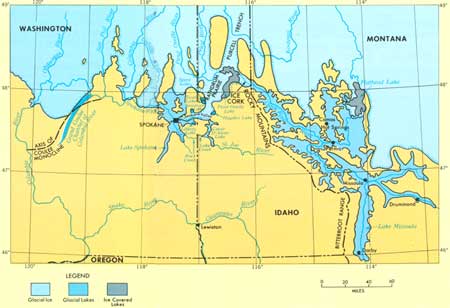
|
Geological Survey
The Channeled Scablands of Eastern Washington |
THE GREAT ICE AGE
Although glaciation began throughout the northern hemisphere at least two million years ago, the important chapter in the glacial history of the Scablands began about 100,000 years ago. At that time glaciers were moving southward from great ice fields in southern British Columbia, following major south-trending valleys leading into the United States. From west to east the valleys are Okanogan, San Poil, Columbia, Colville, Pend Oreille, and Priest River Valleys and the Purcell Trench, a great valley that in places contains the Kootenai River (Fig. 10).

|
| Fig. 10.—The advance of glacial ice and the corking of the Clark Fork River. (click on image for an enlargement in a new window) |
The Okanogan ice lobe encroached far out onto the lava field, and in so doing dammed the Columbia River. This diverted the stream from its course and forced it to flow southward along the Coulee Monocline.
Farther east the Colville lobe reached the edge of the lava field and dammed the Spokane River, creating Glacial Lake Spokane whose surface reached an elevation of about 2,300 feet.
The Purcell lobe scoured its way into a basin that now holds Pend Oreille Lake, and from there moved southwestward across Rathdrum Prairie and Spokane Valley to a point very near the eastern city limits of Spokane.
Glacial debris was deposited along the edges of the Purcell lobe, forming lateral moraines and kame terraces. This debris dammed the mouths of side valleys along the glacier's path and created many lakes. Spirit Lake, Twin Lakes, and Newman Lake on the northwest side of the glacier near Spokane are remnants of larger lakes that existed while the ice occupied the main part of the valley. On the southeast, Hayden Lake, Coeur d'Alene Lake, and Liberty Lake are other examples of lakes formed when the stream valleys became partly or entirely blocked by dams of glacial debris.
The largest lake that formed in the Pacific Northwest during the Great Ice Age was Glacial Lake Missoula, the lake that spawned the flood (Fig. 10, page 9).
| <<< Previous | <<< Contents >>> | Next >>> |
inf/72-2/sec2.htm
Last Updated: 28-Mar-2006